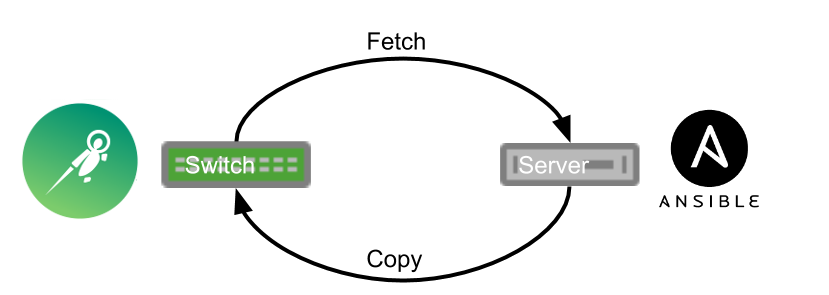Back up Existing Ansible Configurations - NCLU
While you can build a network from the ground up with Ansible using modules or templates, it is possible to grab the networking configuration from a pre-configured network, and even push it back out to the switch.
This type of model can be beneficial for:
- Upgrade scenarios
- Taking a snapshot of the network before trying something new
- Reverting quickly back to a snapshot
- Providing an introduction to automation

Requirements
- Cumulus Linux switch
- Server/laptop for running Ansible
- Install Ansible on the server/laptop
Ansible Modules
The two examples below primarily use these four core Ansible modules:
Example Fetch
On the server is a folder with one file called fetch.yml.
user@server ~/consulting/fetch $ ls
fetch.yml
The content of the file is very simple:
---
- hosts: leaf1
become: yes
tasks:
- name: Fetch ports.conf
fetch: dest=save/{{ansible_hostname}}/ports.conf src=/etc/cumulus/ports.conf flat=yes
- name: Fetch interfaces Configuration
fetch: dest=save/{{ansible_hostname}}/interfaces src=/etc/network/interfaces flat=yes
- name: Fetch FRR daemons file
fetch: dest=save/{{ansible_hostname}}/daemons src=/etc/frr/daemons flat=yes
- name: Fetch frr.conf
fetch: dest=save/{{ansible_hostname}}/frr.conf src=/etc/frr/frr.conf flat=yes
To run the playbook, run the ansible-playbook command:
user@server ~/consulting/fetch $ ansible-playbook fetch.yml
PLAY [leaf1] ******************************************************************
GATHERING FACTS ***************************************************************
ok: [leaf1]
TASK: [Fetch ports.conf] ******************************************************
changed: [leaf1]
TASK: [Fetch interfaces Configuration] ******************************************************
changed: [leaf1]
TASK: [Fetch FRR daemons file] **********************************************
changed: [leaf1]
TASK: [Fetch frr.conf] ******************************************************
ok: [leaf1]
PLAY RECAP ********************************************************************
leaf1 : ok=5 changed=3 unreachable=0 failed=0
The playbook copies these four commonly used Cumulus Linux files to the server:
| File Name | Description |
|---|---|
| /etc/cumulus/ports.conf | Configuration for breakout ports |
| /etc/network/interfaces | Network configuration File |
| /etc/frr/daemons | Daemons configuration file for FRR |
| /etc/frr/frr.conf | FRR Configuration file |
For more information on which files to back up and what Cumulus Linux uses, read Upgrading Cumulus Linux.
The playbook copies the files to a directory called save:
user@server ~/consulting/fetch $ ls
fetch.yml save
The playbook puts the files into a directory based on the hostname. This particular example shows the playbook ran only on one switch named leaf1:
user@server ~/consulting/fetch/save $ ls
leaf1
The playbook stores all the files in the leaf1 directory:
user@server ~/consulting/fetch/save/leaf1 $ ls
daemons interfaces ports.conf frr.conf
Example Copy
On the server, Ansible added a file called copy.yml to the directory; the file has this content:
---
- hosts: leaf1
become: yes
tasks:
- name: Restore ports.conf
copy: src=save/{{ansible_hostname}}/ports.conf dest=/etc/cumulus/
- name: Restore Interface Configuration
copy: src=save/{{ansible_hostname}}/interfaces dest=/etc/network/
- name: Restore FRR daemons file
copy: src=save/{{ansible_hostname}}/daemons dest=/etc/frr/daemons
- name: Restore frr.conf
copy: src=save/{{ansible_hostname}}/frr.conf dest=/etc/frr/frr.conf
- name: reload switchd
service: name=switchd state=restarted
- name: reload networking
command: /sbin/ifreload -a
- name: restart frr
service: name=frr state=restart
This file just pushes back the already saved files, then restarts the corresponding services using the service and command module. Instead of issuing a service=networking command, the ifreload -a command ran directly.
user@server ~/consulting/fetch $ ansible-playbook copy.yml
PLAY [leaf1] ******************************************************************
GATHERING FACTS ***************************************************************
ok: [leaf1]
TASK: [Restore ports.conf] *******************************************************
ok: [leaf1]
TASK: [Restore Interface Configuration] *******************************************************
ok: [leaf1]
TASK: [Restore FRR daemons file] ***************************************************
ok: [leaf1]
TASK: [Restore frr.conf] ******************************************************
changed: [leaf1]
TASK: [reload switchd] ********************************************************
changed: [leaf1]
TASK: [reload networking] *****************************************************
changed: [leaf1]
TASK: [restart frr] *********************************************************
changed: [leaf1]
PLAY RECAP ********************************************************************
to retry, use: --limit @/home/user/copy.retry
leaf1 : ok=8 changed=4 unreachable=0 failed=0
With the files pushed back to the switch, it now operates on the previous snapshot.
You could base the save directory on the time of day rather than a generic folder called save by using:
{{ansible_date_time.time}}
You can find more information on which facts Ansible gathers by reading this article.